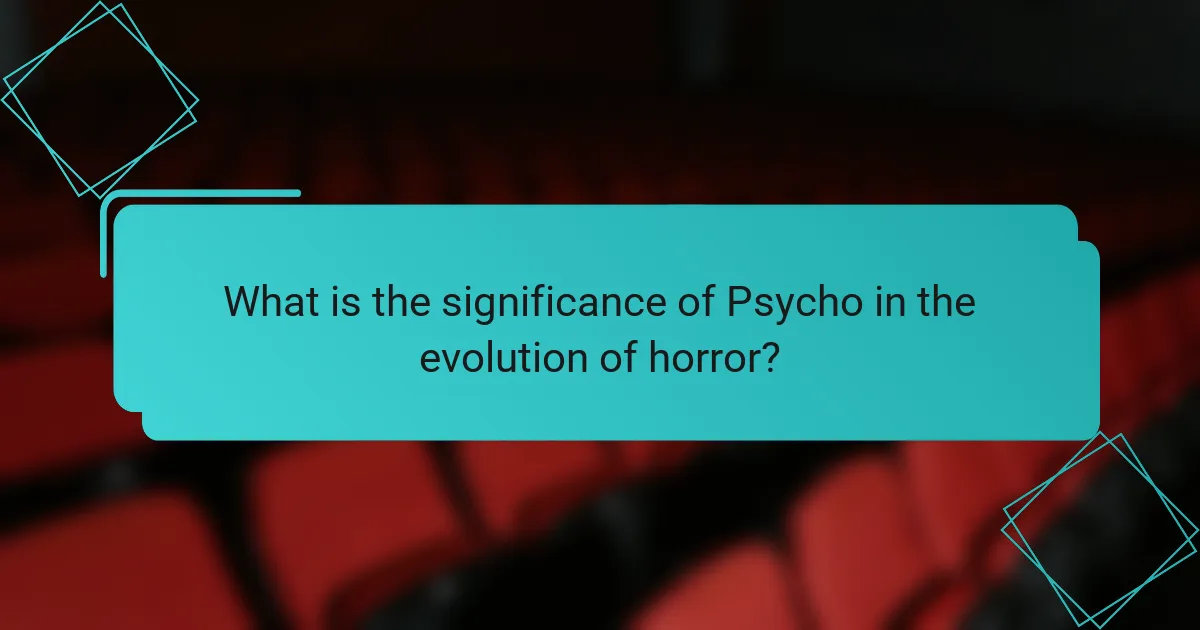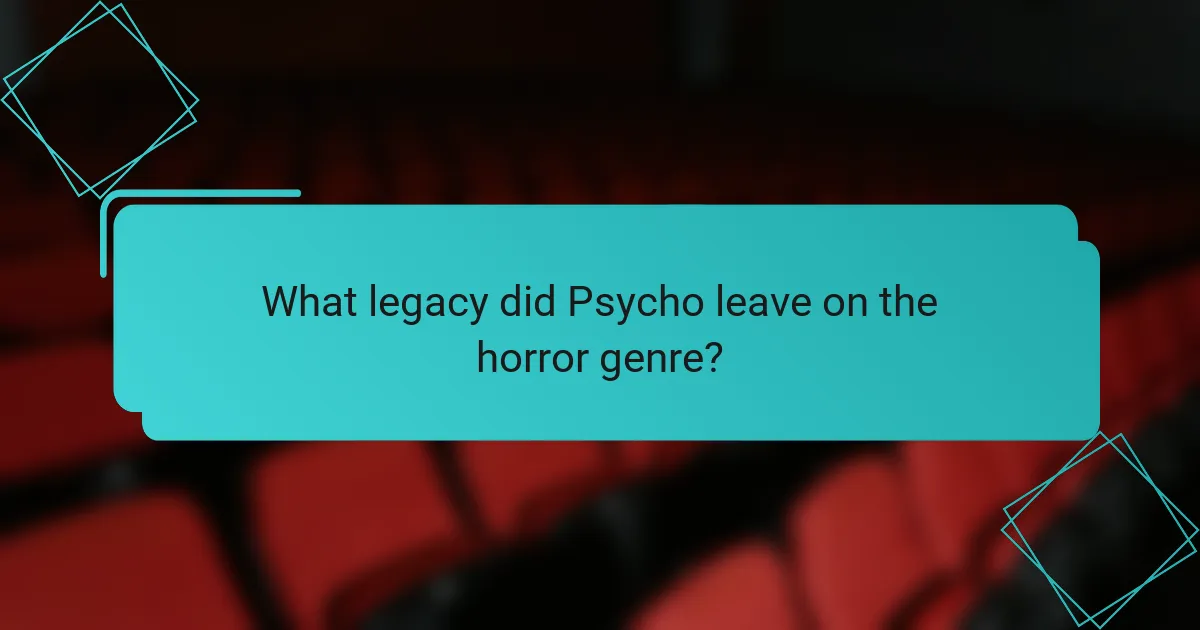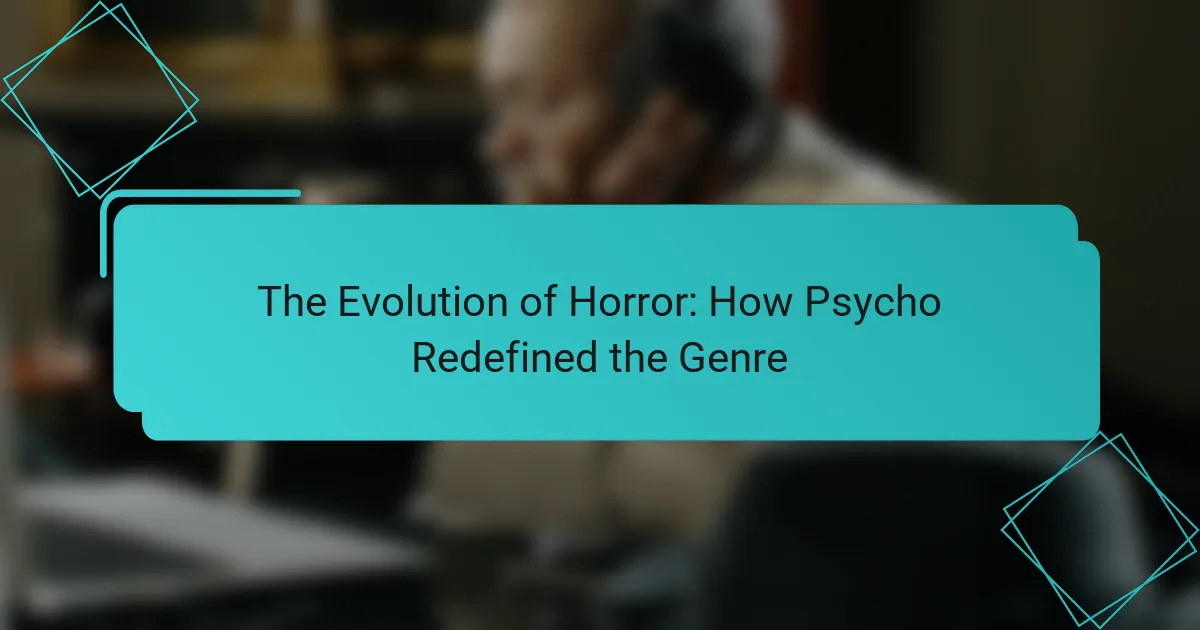Psycho, directed by Alfred Hitchcock, is a landmark film in the horror genre that redefined narrative structure and audience expectations. The film introduced psychological horror by emphasizing character motivations over supernatural elements, notably through the portrayal of the anti-hero Norman Bates. Key cinematic techniques, such as suspenseful editing and a haunting score, particularly in the iconic shower scene, heightened tension and created a visceral emotional response. Psycho’s innovative storytelling and subversion of traditional plot structures established new standards for psychological thrillers and influenced countless subsequent horror films, solidifying its legacy as a benchmark in horror storytelling and cinematic techniques.

What is the significance of Psycho in the evolution of horror?
Psycho is significant in the evolution of horror as it redefined narrative structure and audience expectations. Alfred Hitchcock’s film introduced psychological horror, focusing on character motivations rather than supernatural elements. The shower scene, a pivotal moment, showcased graphic violence and intense suspense, shocking audiences in 1960. Psycho also challenged the morality of its characters, presenting an anti-hero in Norman Bates. This shift influenced future horror films to explore complex characters and themes. The film’s innovative use of music and editing heightened tension, setting a new standard for the genre. Psycho’s impact is evident in subsequent horror films that prioritize psychological depth and realism.
How did Psycho influence the horror genre’s narrative structure?
Psycho significantly influenced the horror genre’s narrative structure by introducing a twist that subverted audience expectations. The film’s shocking plot twist occurs halfway through, with the main character’s death. This unexpected turn shifts the focus from the initial narrative to the antagonist. Psycho also employed a psychological approach, emphasizing character motivations over traditional horror tropes. This shift laid the groundwork for future horror films to explore complex characters. Additionally, its use of suspense and tension redefined pacing in horror storytelling. The film’s innovative editing techniques created a visceral experience, enhancing emotional engagement. These elements collectively transformed narrative structures in horror cinema, paving the way for modern psychological thrillers.
What key themes were introduced in Psycho that changed horror storytelling?
Psycho introduced key themes that significantly changed horror storytelling. It emphasized psychological horror over supernatural elements. The film explored themes of identity and duality through Norman Bates’ character. It also presented the concept of the “final girl,” a trope that became prevalent in horror. The use of suspense and shock, particularly in the infamous shower scene, redefined audience expectations. Additionally, Psycho challenged the norms of morality in horror, depicting complex characters with ambiguous motivations. These themes influenced subsequent horror films, shaping the genre’s evolution.
How did Psycho’s plot twists redefine audience expectations in horror films?
Psycho’s plot twists fundamentally altered audience expectations in horror films by subverting traditional narrative structures. The film famously killed off its lead character, Marion Crane, early in the story. This unexpected turn shocked viewers and challenged their assumptions about protagonist survival. Additionally, Psycho introduced the concept of psychological horror, focusing on the mind’s dark aspects rather than physical threats. The revelation of Norman Bates’ dual identity as both himself and his mother further deepened the psychological complexity. These twists encouraged filmmakers to explore more intricate storytelling techniques. As a result, audiences began to anticipate more sophisticated narratives in horror, moving beyond simple scares. Psycho set a precedent that influenced countless horror films that followed, reshaping the genre’s landscape.
What impact did Psycho have on character development in horror?
Psycho significantly influenced character development in horror by introducing complex psychological profiles. The character of Norman Bates exemplifies this shift with his multifaceted personality. Psycho’s portrayal of Bates challenged the one-dimensional villains typically seen in earlier horror films. This complexity allowed audiences to empathize with the character, despite his horrific actions. Additionally, the film’s focus on the psychological motives behind violence added depth to horror narratives. The emphasis on character psychology paved the way for future horror films to explore deeper themes. Psycho’s impact is evident in later works that prioritize character development, such as The Silence of the Lambs. Thus, Psycho redefined horror by merging character depth with psychological horror.
How did Norman Bates serve as a groundbreaking character in horror cinema?
Norman Bates served as a groundbreaking character in horror cinema by introducing psychological complexity to the genre. His character embodies the themes of duality and madness, which were not commonly explored in earlier horror films. Bates is both a charming motel owner and a disturbed individual, showcasing the conflict between his public persona and his hidden identity. This duality creates a sense of unpredictability, enhancing the horror experience. The character’s psychological depth was revolutionary, as it shifted focus from traditional monsters to the human psyche’s darker aspects. Alfred Hitchcock’s “Psycho,” released in 1960, marked a turning point in horror, emphasizing character-driven narratives. The film’s exploration of mental illness through Bates influenced countless subsequent films, establishing a template for complex villains.
What psychological elements were explored through the characters in Psycho?
The psychological elements explored through the characters in Psycho include identity, guilt, and the duality of human nature. Norman Bates embodies the struggle between his innocent persona and his darker impulses. This duality highlights the conflict between societal expectations and personal desires. Marion Crane’s character illustrates the psychological effects of guilt and desperation. Her actions lead to a breakdown of her moral compass. The film also examines the theme of isolation, as characters are often depicted in solitary settings. This isolation amplifies their psychological struggles. Overall, Psycho delves into the complexities of the human psyche, revealing the fragility of mental health.

How did Psycho’s cinematic techniques reshape horror filmmaking?
Psycho’s cinematic techniques revolutionized horror filmmaking through innovative storytelling and visual style. Alfred Hitchcock employed suspenseful editing, particularly in the infamous shower scene, which used rapid cuts to heighten tension. This technique created a visceral emotional response in the audience. The film also utilized unconventional narrative structures, including the unexpected death of the main character early on. This subversion of audience expectations was groundbreaking. Additionally, Psycho’s use of a haunting score intensified the psychological horror elements. The combination of these techniques set new standards for the genre. Psycho influenced countless filmmakers, establishing a template for psychological thrillers and horror films that followed.
What innovative filming techniques were used in Psycho?
Psycho employed several innovative filming techniques that contributed to its groundbreaking impact. Alfred Hitchcock used a technique called “the shower scene montage.” This involved rapid cuts to create tension and shock. The iconic scene features 70 shots edited together in just 45 seconds. Another technique was the use of a handheld camera for dynamic movement. This added a sense of realism and urgency. Hitchcock also utilized unconventional camera angles, such as extreme close-ups. These angles heightened emotional responses and emphasized characters’ psychological states. The film’s black-and-white cinematography enhanced the mood and atmosphere. It allowed for stark contrasts that intensified the horror elements. These techniques collectively redefined the horror genre and influenced future filmmakers.
How did the use of music and sound design contribute to Psycho’s suspense?
The use of music and sound design in Psycho significantly enhanced its suspense. Bernard Herrmann’s score, particularly the shrill strings, created an atmosphere of tension. The music swells during key moments, amplifying fear and unease. Silence is also strategically employed to heighten anticipation. For instance, the absence of sound before a shocking scene increases the impact of the ensuing violence. The iconic shower scene features piercing violins that evoke a visceral reaction. The combination of these auditory elements keeps viewers on edge throughout the film. Psycho’s innovative sound design set a new standard for suspense in horror cinema.
What role did editing play in enhancing the horror experience in Psycho?
Editing in Psycho played a crucial role in amplifying the horror experience. The film utilized rapid cuts during tense scenes, creating a sense of urgency and fear. For instance, the infamous shower scene features quick, jarring edits that heighten the viewer’s anxiety. These abrupt transitions prevent the audience from fully processing the violence, enhancing the shock factor. Additionally, the use of close-ups in editing emphasizes the characters’ terror, making the horror more personal. The editing rhythm contributes to the film’s suspense, effectively engaging the audience. This innovative approach set a new standard for horror films, influencing future productions.
How did Psycho’s marketing strategies change the promotion of horror films?
Psycho’s marketing strategies revolutionized the promotion of horror films by introducing a focus on secrecy and audience experience. The film’s director, Alfred Hitchcock, employed a unique campaign that emphasized not revealing the plot twists. This strategy created intrigue and compelled audiences to watch the film without prior knowledge of its shocking elements. Hitchcock’s insistence on no late admissions to theaters heightened the suspense for viewers. The marketing also utilized bold visuals and memorable taglines, such as “The Masterpiece of Shock,” to attract attention. Psycho’s advertising approach set a precedent for future horror films, encouraging filmmakers to prioritize suspenseful narratives and audience engagement in their marketing efforts. This shift in strategy led to a more immersive viewing experience, influencing how horror films were promoted thereafter.
What unique approaches did Psycho take in its advertising campaign?
Psycho utilized groundbreaking techniques in its advertising campaign. It famously employed a strategy of secrecy around its plot. The film’s director, Alfred Hitchcock, insisted on no spoilers in promotional materials. This created a sense of intrigue and urgency for audiences. Hitchcock also used a novel approach by personally overseeing the marketing. He crafted a compelling narrative around the film’s release. The campaign included a strict policy that no one could enter the theater after the film had started. This generated buzz and heightened anticipation. Additionally, Psycho’s advertisements featured bold visuals and striking taglines. These elements effectively captured the film’s psychological horror essence.
How did audience reactions to Psycho influence future horror marketing?
Audience reactions to Psycho significantly influenced future horror marketing strategies. The film’s shocking twists and intense suspense created a new standard for horror. Marketers began to emphasize psychological elements in their campaigns. They focused on evoking fear and suspense rather than just showcasing gore. Psycho’s marketing utilized secrecy, encouraging audiences to avoid spoilers. This tactic increased anticipation and ticket sales. The tagline “The most shocking thing you will ever see!” set a precedent for bold promotional claims. Psycho’s success demonstrated the power of audience engagement in horror marketing. This approach has shaped countless horror films and their marketing campaigns since its release.

What legacy did Psycho leave on the horror genre?
Psycho established a new standard for psychological horror. It shifted the genre’s focus from supernatural elements to human psychology. Alfred Hitchcock’s direction emphasized suspense and character development. The infamous shower scene became iconic for its shocking violence. This scene influenced countless horror films that followed. Psycho also introduced the concept of the unreliable narrator. The film’s twist ending redefined audience expectations for plot structure. Its impact is evident in later films like Halloween and Scream. Psycho’s legacy endures as a benchmark for horror storytelling and cinematic techniques.
How has Psycho influenced subsequent horror films and directors?
Psycho has significantly influenced subsequent horror films and directors by introducing psychological elements and narrative twists. The film’s innovative use of suspense and shock redefined audience expectations in horror. Alfred Hitchcock’s portrayal of Norman Bates created a complex antagonist, influencing character development in later films. Psycho’s infamous shower scene set new standards for violence and editing techniques in horror cinema. Many directors, including John Carpenter and Wes Craven, cited Psycho as a pivotal inspiration for their works. The film’s themes of identity and madness have become staples in the horror genre. Its success demonstrated the commercial viability of psychological horror, encouraging studios to invest in similar projects. Psycho’s legacy continues to shape horror filmmaking today.
What are some notable films that draw inspiration from Psycho?
Notable films that draw inspiration from Psycho include “Texas Chainsaw Massacre,” “Halloween,” and “Silence of the Lambs.” “Texas Chainsaw Massacre,” released in 1974, mirrors Psycho’s themes of isolation and family dysfunction. “Halloween,” from 1978, employs similar suspense techniques and a masked killer. “Silence of the Lambs,” released in 1991, features psychological manipulation and a complex antagonist, echoing Norman Bates’ character. These films showcase the lasting influence of Psycho on the horror genre.
How have modern horror films incorporated elements from Psycho?
Modern horror films have incorporated elements from Psycho by utilizing psychological tension and surprise twists. Psycho introduced the concept of a complex antagonist, influencing character development in contemporary horror. Many modern films adopt the use of a shocking twist to engage audiences, similar to the infamous shower scene. The theme of unreliable narrators has also become prevalent, echoing Norman Bates’ duality. Additionally, cinematographic techniques such as close-ups and dramatic lighting from Psycho have been emulated to enhance suspense. Films like Scream and Hereditary reflect these influences, showcasing how Psycho redefined horror conventions. The legacy of Psycho’s approach to fear continues to shape the narrative structure of modern horror cinema.
What lessons can filmmakers learn from the success of Psycho?
Filmmakers can learn the importance of subverting audience expectations from the success of Psycho. Alfred Hitchcock’s film masterfully manipulated the narrative, leading viewers to believe they understood the plot. The shocking twist of the protagonist’s early demise changed the course of the story. This unexpected turn engaged audiences and created a lasting impact on the horror genre. Additionally, Psycho demonstrated the effectiveness of psychological tension over graphic violence. The film relied on suspense and atmosphere, which heightened fear without explicit content. Filmmakers should also note the significance of strong character development. Norman Bates’ complex personality added depth to the horror, making the audience empathize with him. Finally, Psycho highlighted the power of sound and score in building tension. Bernard Herrmann’s iconic score played a crucial role in amplifying the film’s suspenseful moments. These lessons emphasize the value of innovation, character depth, and psychological engagement in filmmaking.
How can the psychological depth of characters enhance horror storytelling?
Psychological depth of characters enhances horror storytelling by creating relatable fears and complexities. This depth allows audiences to connect emotionally with characters. When viewers understand a character’s motivations and fears, the tension increases. Complex characters evoke empathy, making their peril more impactful. For example, in Alfred Hitchcock’s “Psycho,” Norman Bates’ troubled psyche intensifies the horror. His duality creates suspense and unpredictability. Research indicates that well-developed characters lead to greater audience engagement. The psychological intricacies make the horror feel more real and personal. Thus, depth in character psychology is crucial for effective horror narratives.
What practical tips can aspiring filmmakers apply from Psycho’s techniques?
Aspiring filmmakers can apply several practical tips from Psycho’s techniques. First, utilize suspense through pacing. Psycho effectively builds tension by controlling the rhythm of scenes. Second, employ unexpected plot twists. The shocking turn in the narrative keeps audiences engaged. Third, focus on character development. The depth of Norman Bates adds complexity to the story. Fourth, use innovative camera angles. Hitchcock’s unique perspectives enhance the visual storytelling. Fifth, incorporate sound design strategically. The iconic score amplifies emotional impact. Lastly, challenge audience expectations. Psycho subverts typical horror tropes, creating a memorable experience. These techniques contribute to Psycho’s lasting influence on the horror genre.
The main entity of the article is Alfred Hitchcock’s film “Psycho,” which is pivotal in the evolution of the horror genre. The article outlines how “Psycho” redefined narrative structures, introduced psychological horror, and emphasized character complexity, particularly through the character of Norman Bates. It discusses key themes such as identity, morality, and the use of innovative cinematic techniques, including editing and sound design, that heightened suspense. Additionally, the article examines the film’s marketing strategies and its lasting legacy on subsequent horror films and directors, highlighting its influence on character development and audience expectations.
